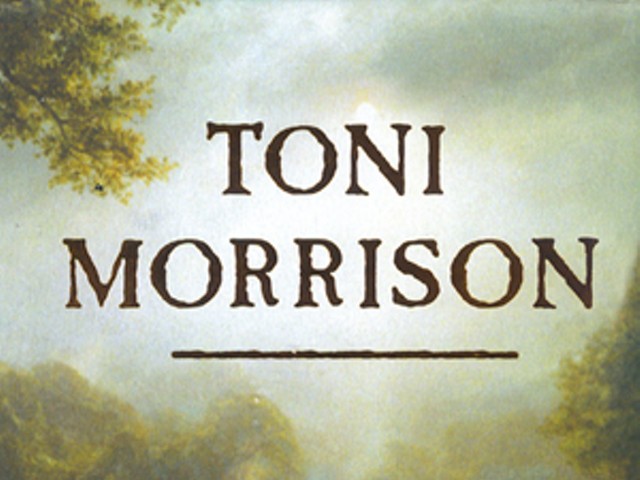This year, we've seen a profusion of books that relate to our region, rolling off the presses everywhere from national trade publishers to university presses to even local individuals. So whatever the bookworms in your life are interested in, there's a volume related to Detroit, the state or the region that'll fill their stockings.
For instance, this year has been especially rich in books about local architecture. Among the best is Great Architecture of Michigan (Michigan Architectural Foundation, 212 pp., $60, hardcover), a book celebrating Michigan's meeting places, amusement centers, houses of state, schools, museums, churches, workplaces and residences. Ranging statewide, from the dense cluster of wonders in downtown Detroit to the upper reaches of the Keweenaw Peninsula, the survey includes not just skyscrapers and office towers, but even a few 19th century farms and factories, tautly summarized by the Free Press' John Gallagher and beautifully photographed by Balthazar Korab.
For an in-depth look at one architectural showpiece, consider The Guardian Building: Cathedral of Finance by James W. Tottis (Painted Turtle Press, 192 pp., $50, clothbound). The outstanding downtown monument represents a superior achievement from the last great decade for stone-and-brick-clad buildings. Built just before the onset of the Great Depression, it drew on the talents of the area's craftsmen and artisans, as well as the remarkable aesthetic sensibility of architect Wirt C. Rowland. Author Tottis offers a tour of the building from top to bottom, accompanied with 133 handsome illustrations and photographs.
For tastes that run humble, there are some good titles to choose from, including Beauty on the Streets of Detroit (self-published, 176 pp., $19.95, paperback). This volume celebrates the often artful working-class residences of a city known for its high rate of home ownership. Though many houses featured here are gone, Bill Rauhauser's loving black-and-white photos and Mary Desjarlais' commentary offer lasting proof of what was. It's available locally at Book Beat (26010 Greenfield Rd. Oak Park; 248-968-1190).
T. Burton's Home in Detroit (Shaking the Tree, $18.99, 144 pp., hardcover) celebrates the bungalows, mansions, colonials, ranches and apartment buildings that have been home to the scores of stars from the city. It features profiles of celebs with a D-Town connection (including such diverse notables as Rosa Parks, Charles Lindbergh, Casey Kasem, Ivan Boesky, Gilda Radner, Henry Ford, Lily Tomlin, Diana Ross, Ty Cobb, Marvin Gaye and Ted Nugent) along with photographs of the places they once called home. Better still, for every copy sold, $5 goes to local nonprofit Motor City Blight Busters.
If you're shopping for a fan of Detroit history who's less interested in text than in photography, this year saw a new slew of Arcadia Press' appealing historical photographic paperbacks (all costing about $20). This year, Arcadia's Detroit titles include books about crime (Detroit's Infamous Purple Gang), local sports (Metro Detroit's High School Football Rivalries), music (Motor City Rock and Roll: The 1960s and 1970s), public service (The Detroit Police Department) and shopping (20th-Century Retailing in Downtown Detroit). Fans of Detroit's many bars and saloons will enjoy Detroit's Historic Drinking Establishments, with its unprecedented collection of photographs documenting such watering holes as Russell House, the Gayety, Chin Tiki, the Flame Show Bar, Lindell A.C. and Cliff Bell's, with a special eye to taverns' roles as civic meeting places, and a doff of the cap to Detroit's Prohibition-era speakeasies and historic cigar and brewing businesses.
There's no shortage of gift ideas for fans of sport. For the bathroom reader, there's The Great Book of Detroit Sports Lists (Running Press, 336 pp., $14.95, paperback). Detroit sports radio jocks Mike Stone and Art Regner have put together this work for the local sports fanatic, featuring hundreds of pages of lists to help fans of Detroit teams keep score.
And when it comes to books chronicling the Detroit Tigers, publishers have gone into extra innings. Perhaps the most handsome volume is The Detroit Tigers: A Pictorial Celebration of the Greatest Players and Moments in Tigers History by William M. Anderson (Wayne State University Press, $39.95, 328 pp., hardcover), a photo history spanning the team's 107-year history. There's also Sock It To 'Em Tigers: The Incredible Story of the 1968 Detroit Tigers by Mark Pattison and David Raglin (Potomac Books Inc., 400 pp., $24.95, paperback), telling how the team delivered the goods, winning the pennant for Detroit after one of its toughest years, with blow-by-blows on their "thrilling come-from-behind wins" and profiles of each player involved.
For fans of the prewar Tigers (who won't hazard eBay bidding wars), Frederick George Lieb's classic history of the ballclub, The Detroit Tigers (Kent State University Press, 306 pp., $18, paperback), published in 1946, is rereleased in a paperback facsimile reproduction perfect for ball buffs.
For art connoisseurs, there's a new edition of the handy guidebook, Art in Detroit Public Places (Great Lake Books Series, $24.95, 248 pp., paperback), in which local professor and sometimes Metro Times art critic Dennis Alan Nawrocki considers more than 150 pieces of public art in metro Detroit. The detailed street maps should help readers plan their own personal tours, though the lovely photographs by David Clements (of Talking Shops fame) will do if foul winter weather makes a real tour impractical. The volume is also an effort to raise awareness of these treasures, as our artistic and architectural heritage is "always under threat from new development and sprawl."
For gearheads, we suggest The Complete Book of Classic GM Muscle (Motorbooks, 336 pages, $55, hardcover), a coffee-table book on the golden age of the gas-guzzler, lavishly illustrated with photos of Chevys, Pontiacs, Buicks and Oldses, as well as brochure art and technical illustrations. This volume doesn't stint on details, with exhaustive looks at the muscle-bound machines GM churned out from the early '60s until the '70s oil shocks.
Going further back, there's The Ford Model T: The Car That Put the World on Wheels, by Lindsay Brooke (Motorbooks, 208 pp., $40, hardcover), which tackles the Tin Lizzie, introduced 100 years ago, illustrating the mechanical innovations that went into producing it. The tome traces Ford's "flivver," from transportation workhorse to platform for T-bucket hotrods, all with period art and lovely photographs.
It's no surprise that books about the black experience are well-represented. Among the most fascinating is a story that's only partly set in Detroit: I've Got a Home in Glory Land: A Lost Tale of the Underground Railroad by Karolyn Smardz Frost (Farrar, Straus and Giroux, $18, 480 pp., paperback). It tells the tale of Lucie and Thornton Blackburn's harrowing escape from slavery in Louisville, Ky., including their dramatic arrest as fugitives in Detroit and their subsequent escape to Canada, which set off the Detroit race riot of 1833. Smardz deserves praise for taking a little-known story and bringing it to life with high, almost cinematic drama.
For a more academic look at African-Americans looking North for social equity, Thomas Sugrue presents Sweet Land of Liberty: The Forgotten Struggle for Civil Rights in the North (Random House, $35, 720 pp., hardcover). This doorstopper isn't specifically about Detroit, but tales of our city recur frequently in this revisionist history, which rethinks the chronology and geography of the movement for equality. What's more, Detroit-born Sugrue is the author of the essential Detroit book Origins of the Urban Crisis.
Also not entirely about Detroit (and going back a couple years) is Seven Fires: The Urban Infernos That Reshaped America by Peter Charles Hoffer (Public Affairs, $26, 480 pp.). Alongside the Boston Fire of 1760 (helping spark the American Revolution) and the Chicago Fire of 1871 (making way for the modern skyscraper), we get the Detroit conflagration of 1967 (making clear how little the civil rights movement had bettered lives up North). The book's provocative thesis? Detroit would have been better off if downtown had burned.
Also not from this year is the nonetheless worthy When You Come Home: A Wartime Courtship in Letters, 1941-45 (Wayne State University Press, $26.95, 369 pp., paperback) written and edited by former Detroiter Robert E. Quirk. Before he could marry his sweetheart, Quirk was whisked off into the service for World War II. The carefully preserved correspondence between him and his future wife here tells the story of a Detroit GI fighting the Axis powers, with home front insights from his Dearborn sweetheart. Trace their budding romance, follow wartime events and mourn the lost art of letter-writing.
If you're hunting for something Detroit-themed for those who don't read much, local-themed calendar options abound, including an Arcadia offering, Detroit 1930-1969, with 12 stunning, sepia-toned images of a throng-packed city. The Detroit Historical Society has produced the fact-packed Days of Detroit, with photos of historic people (including Joe Louis and Walter Reuther), as well as 365 individual Detroit anniversaries for each date. For those who love architecture, Momentum Books gives us the Detroit: City Beautiful calendar, with 12 photographs of Detroit's landmark buildings. And, for the Hamtown enthusiast, the Hamtramck Historical Commission offers Hamtramck: Two Square Miles Rich in History, with a variety of historic photos and H-town milestones to mark each and every day.
Michael Jackman is a writer and copy editor for Metro Times. Send comments to [email protected]




